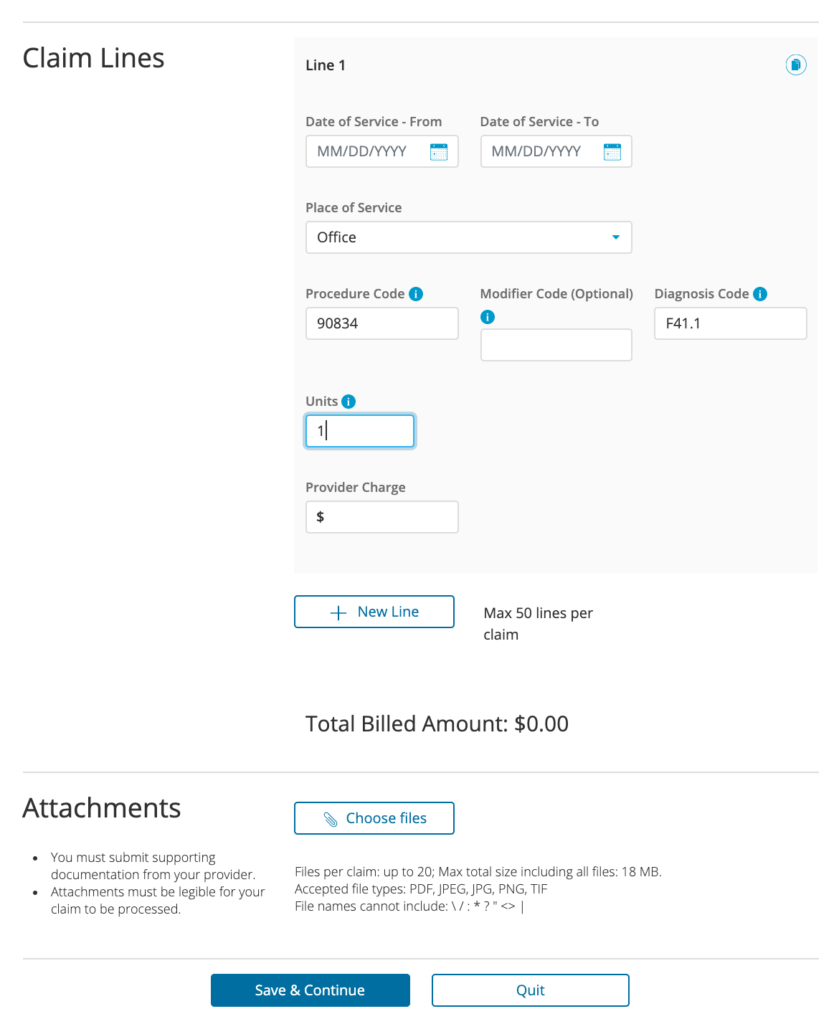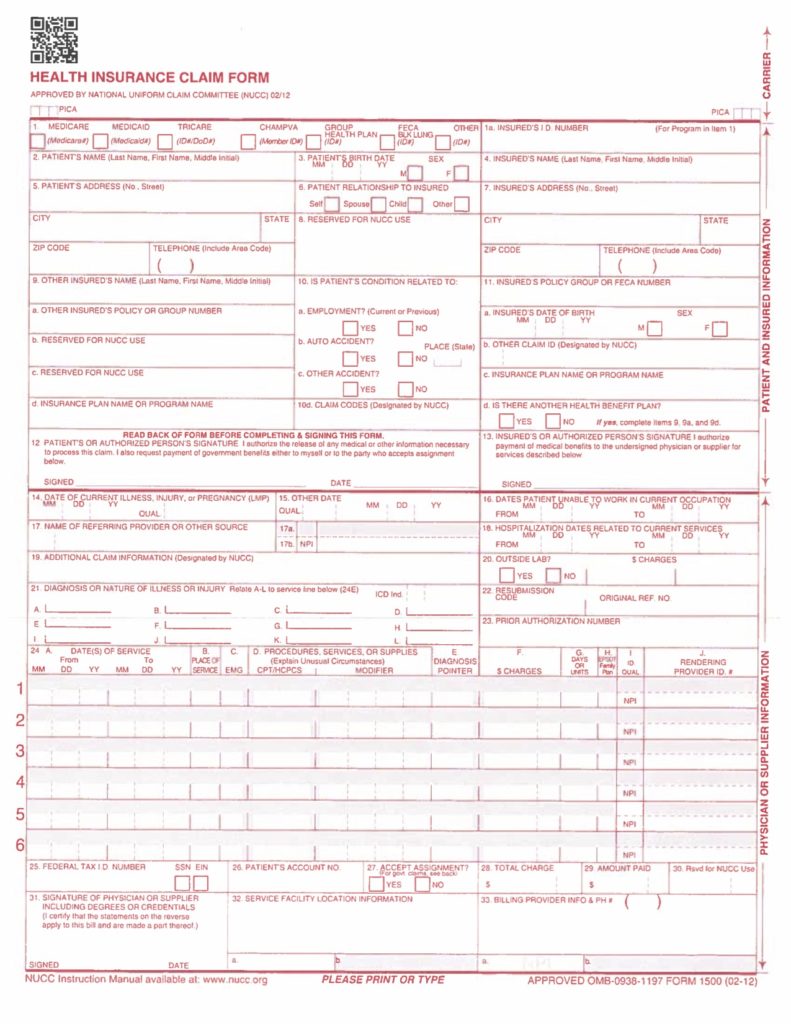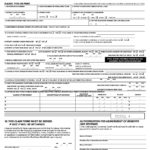Filing for reimbursement for psychotherapy is actually very simple! You can do it online, or by mail. Here’s how.
Most of the more skilled and experienced psychotherapists in the Washington, DC area are “out of network” providers, meaning you’ll pay your therapist directly, and then submit a claim for reimbursement from your insurance company.
Your therapist can help answer any questions you have, but here’s your very own handy-dandy guide. (I’ve also written a guide for how to make sure you get fair and accurate reimbursement for psychotherapy from your insurance.)
Filing your claim online
It’s very likely that you can file your claims for reimbursement online, on your insurance company’s website.
- Sign in to your account on your health insurance company’s website.
- Find “Submit a claim online”.
- Fill in the info they request.
- Scan and upload a copy of your psychotherapist’s bill.
That’s it!
Here’s the info they’ll request – all of this will be on the statement your therapist gives you:
- Provider’s name and address
- Provider’s tax ID number (might be TIN, EIN, FEIN, or SSN)
- Diagnosis code (“ICD”) – for example, “F41.1” for Generalized Anxiety Disorder
- Procedure code (“CPT”) – for example, “90834” for Individual Psychotherapy, 45 minutes
Here’s an example of a page from an online claim, showing some claim information filled out, and the button you’d click to attach a copy of your therapist’s bill:

Filing your claim by mail
If you aren’t able to file your claim for reimbursement online, you’ll fill in a paper claim form, attach a copy of your therapist’s bill, and mail it to your insurance company.
You can find the claim form on your insurance company’s website, where you can print it out. (Some insurance companies use a different claim form for psychotherapy – it might be called a “behavioral health” claim form.)
Helpful Hint: If you’ve already paid your psychotherapist, and you’re filing for reimbursement, write in bold letters (and highlight) on the claim form, “PATIENT HAS ALREADY PAID PROVIDER – PLEASE REIMBURSE PATIENT”.
Diagnosis. You’ll enter this as a code, which will be on your therapist’s invoice, probably next to the abbreviation “ICD-10” – for example, “ICD-10: F41.1”.
Place of service. For psychotherapy in your therapist’s office, the code will typically be “Office,” which is code “11.”
Description of Services, or CPT. “CPT” is the code for what kind of service your therapist provided, and should be on your therapist’s invoice. For example, “Individual Psychotherapy, 45 minutes” is “CPT 90834.”
Your therapist’s NPI number. If your therapist has one, it’ll be on their invoice. If they don’t, the insurance company will still process your claim; just write “none.”
Provider’s signature. Fill this in with “See attached invoice.” Most of the time, this is sufficient.
Assignment. Don’t sign anything that says “authorize assignment”, since you’ve already paid your therapist and are filing for reimbursement. If you authorize or assign your benefit, that means the insurance company will send payment to your therapist instead of you.
If your insurance company is really kickin’ it old school…
The old standard “universal” insurance claim form is called a HCFA (“HICK-fah”) form, or CMS-1500 form, and a sample one is shown below.
How to fill out a HCFA / CMS-1500 to get reimbursed for psychotherapy
If your insurance company requires you to fill out a HCFA or CMS-1500 form, here are box-by-box instructions.
Box 1: Check “Group Health Plan” if your health insurance is through your employer, or the Affordable Care Act (“Marketplace”).
Box 1a: Enter the ID# printed on your insurance card.
Box 3 and 5: This is your information.
Box 4: If you’re the policy holder, enter your name here. If you have insurance through a parent’s or spouse’s policy, enter their name instead.
Box 6: Your relationship to the insured. Check “self” if your insurance policy is in your own name.
Box 7: Your address and phone, or if the insurance is through someone else, such as a spouse or parent, enter theirs.
Box 8: Check the boxes that apply.
Box 9: This is only used if you have multiple insurances.
Box 10: The answers to these questions are all typically “no.”
Box 11: Group number, found on your insurance ID card.
Box 11a: Your date of birth, or if the insurance is through someone else, enter theirs.
Box 11b-c: You can leave these blank.
Box 11d: Check “No” if you only have one health insurance policy, If you have two insurances, check “yes” (and see Box 9).
Box 12: Sign and date.
Box 13: Don’t sign this box, since you’ve already paid your therapist and are filing for reimbursement. Otherwise, the insurance company will send payment to your therapist instead of you.
Boxes 14-20: Leave blank.
Box 21: Enter the diagnosis code(s). This should be on your therapist’s invoice, and it’ll be a code that comes after “ICD” — for example, on the invoice it’ll probably say something like “ICD-10: F41.1”, in which case you’d just write the code “F41.1”.
Box 22: Leave blank.
Box 23: Leave blank, unless you had to get a prior authorization to see your therapist.
It’s best to include just one psychotherapy session per line, so:
Box 24a: Date of service (same date for “from” and “to”)
Box 24b: Place of service. For psychotherapy in your therapist’s office, the code will typically be “Office,” which is code “11.”
Box 24c: Leave blank.
Box 24d: “CPT” is the code for what kind of service your therapist provided, and should be on your therapist’s invoice. For example, Individual Psychotherapy, 45 minutes is CPT 90834.
Box 24e: Leave blank.
Box 24f: The amount your therapist charged.
Box 24g: Units – in this case “1”, since you’re entering one session per line.
Box 24h: Leave blank.
Box 24i: Leave blank.
Box 24j: Your therapist’s NPI number, if they have one. If they don’t, the insurance company will still process your claim; just write “none” here.
Box 25: Your therapist’s Tax ID number (EIN) or Social Security number (SSN).
Box 26: Leave blank.
Box 27: Check “No” since you’ve already paid your therapist and are filing for reimbursement.
Box 28: Total of all charges listed in Box 24 above.
Box 29: Amount you paid.
Box 30: Leave blank.
Box 31: Fill this in with “See attached invoice.”
Box 32: Leave blank unless you were seen at a clinic.
Box 32a: Leave blank.
Box 33: Your therapist’s phone number and address.
Box 33a: Your therapist’s NPI number (see 24j above).


